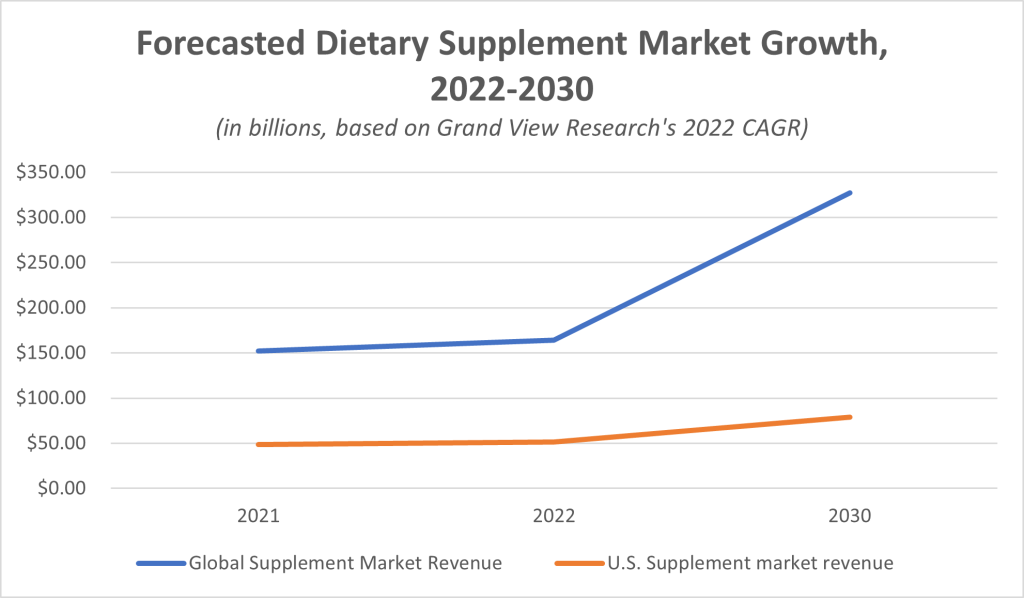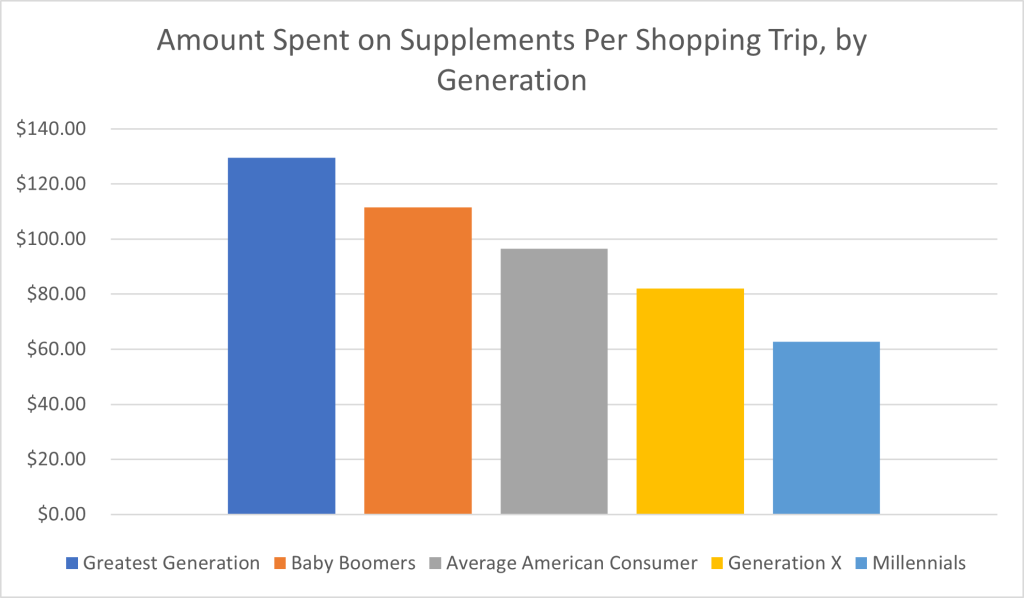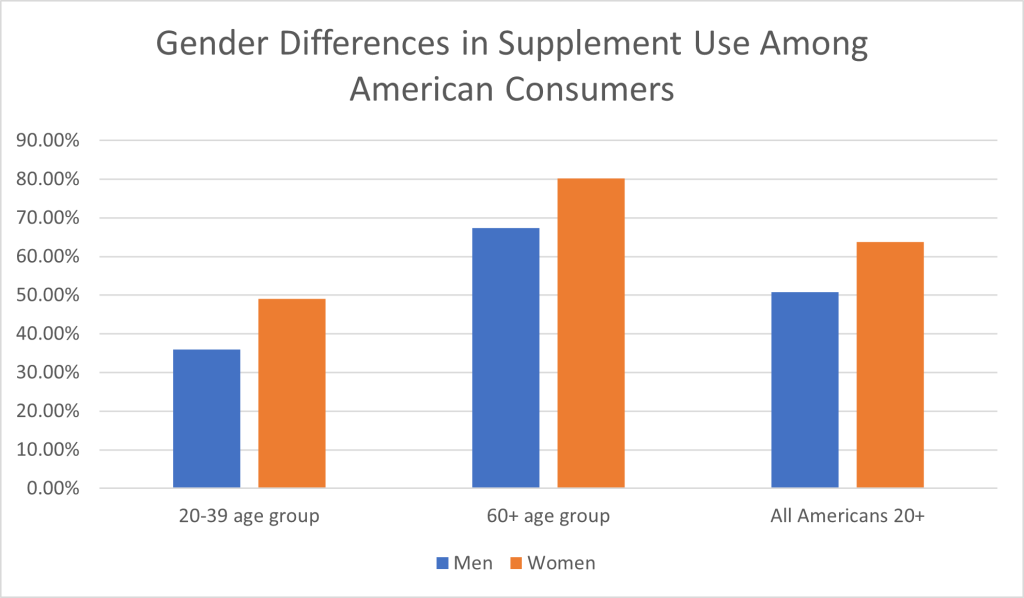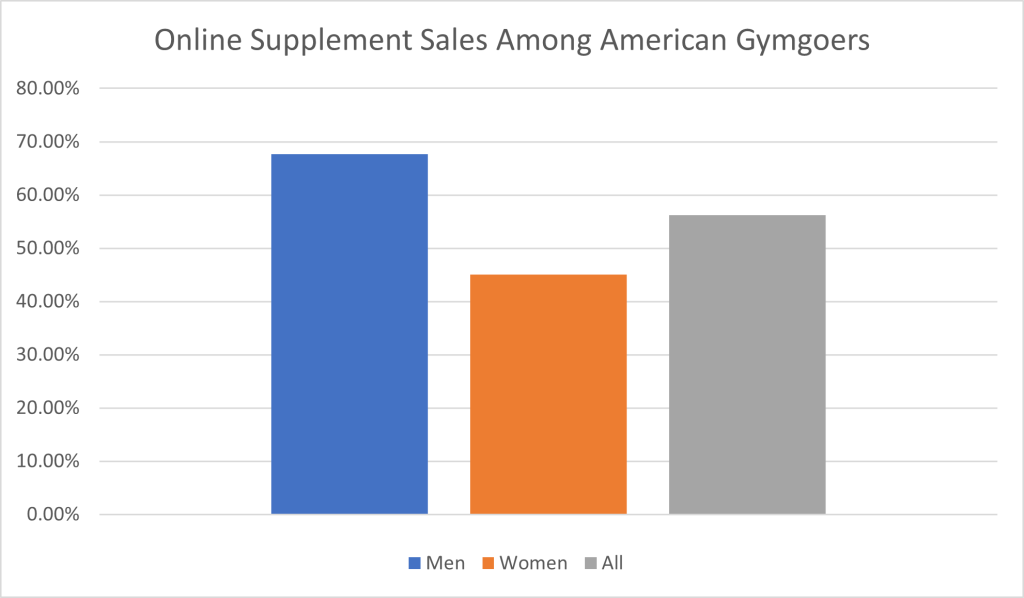If you’re taking dietary supplements – from daily vitamins and weight management supplements to energy bars, protein supplements, and other sports nutrition products – you’re in good company.
Both across the United States and all over the world, the supplement industry is booming. The question is, who’s buying?

Dietary Supplement Industry Statistics
The global supplement industry amounted to a market size of $151.9 billion (in U.S. dollars) in 2021, an analysis by market research and consulting company Grand View Research found. By the end of the forecast period from 2022 through 2030, the dietary supplement market was expected to grow by a compound annual growth rate of 8.9%, more than doubling over the course of less than a decade to reach $327.4 billion in revenue.
Dietary supplement industry statistics for the United States alone put the total market size at $48.4 billion in revenue as of 2021. Over the forecast period from 2022 through 2030, the U.S. market is expected to grow by 5.6%, climbing to $79.04 billion in revenue.

Today, the majority of consumers tend to support dietary supplement use. A 2019 report by The Hartman Group found that 58% of consumers see vitamins and other nutritional supplements as having an “important role” in health and wellness.
However, the embrace of the supplement industry isn’t universal or uniform. To better understand the dietary supplement market as a whole, it makes sense to ask questions about the demographics of supplement users and purchasers. What populations or categories of people are contributing most to the growth of this industry?
The Major Populations Supporting the Dietary Supplement Industry
A 2022 survey conducted by the Council for Responsible Nutrition (CRN) found that the highest rates of supplement use tend to involve the following populations:
- Older adults
- Women
- Households with higher levels of income, education, or both
In general, the use of supplements in America is high, although there has been some decline since supplement usage rates hit their peak in the midst of the COVID-19 pandemic. The majority of American consumers – 75% – reported taking dietary and nutritional supplements, the CRN reported, and the “vast majority” of these users take supplements routinely.
RELATED: What Do Americans Spend the Most Money On?

The Dietary Supplement Market by Age
All age groups can benefit from taking vitamins and supplements that help them achieve optimal health and wellness. Daily vitamins, for example, are recommended for ages ranging from infancy to old age. Still, age is a major factor in the demographics of the dietary supplement industry and in the usage of different kinds of vitamins and supplements.
The Thriving Adult Segment of the Supplement Industry
On the whole, the adult segment of the market made up the largest share of all age groups in 2021, accounting for 46.6% of the global dietary supplements market, according to Grand View Research. This reality reflects the types of dietary supplements that drive market growth – like sports nutrition supplements and weight loss supplements – which are most commonly used by adults.
The prevalence of supplement use among adult age groups also aligns with one of the primary reasons for the growing consumption of dietary supplements: working people (namely, adults) struggle to find the time to prepare and eat healthy foods with their hectic work schedules.
Supplement Use Across Age Groups
Still, supplement use is growing across the board. Globally, the use of nutrition supplements among infants and children is expected to grow, Grand View Research reported. The categories of end-users Grand View Research highlighted as the most important populations for the global dietary supplements market include adults, geriatric consumers, children, infants and pregnant women (that is, women in their childbearing years).
A 2021 report by Grand View Research that focused specifically on the North American market predicted that the infant age group would see the highest growth rate – 10.1% – over the forecast period of 2021 through 2028.
Supplement Industry Spending Across Generations
Among adult age groups, the geriatric population is the population that spends the most on dietary supplements. On average, Americans spend $96.50 per shopping trip, online recruitment platform Zippia reported in June 2022. Invariably, the oldest generations of Americans spend the most money, as measured by the average supplement shopping trip amount, Zippia reported.

Part of the reason for this outcome is likely that aging adults need more support to achieve optimal health than younger adults, but that’s not the only cause of the spending discrepancy. Younger age groups report using more coupons, including coupons presented via mobile devices, than older age groups, according to WholeFoods Magazine.
On average, the surviving members of the Greatest Generation spend $129.58 per shopping trip, according to Zippia. These consumers were born between 1901 and 1924 and are now aged 98 to 121. The Baby Boomers, generally defined as those born between 1946 and 1964 (58 to 76 years old now), reported spending $111.59.
The now-42- to 57-year-old Generation X-ers (born between 1965 and 1980) spent $82.06 on supplements per shopping trip. Millennials – born between 1981 and 1996 and now aged 26 to 41 years old – reported spending $62.73 per shopping trip on supplements. That’s less than half what the (mostly) centenarians who make up the surviving Greatest Generation are spending on the supplement industry.
Despite the significant difference in spending, Millennials aren’t exactly falling behind other generations when it comes to supplement use. In fact, a survey by the Hartman Group (cited in this 2019 LinkedIn post) found that 45% of Millennials took supplements regularly. While that’s still a significantly lower percentage than the 69% of Baby Boomers who take supplements, it’s a high rate of usage for such a relatively young generation.
In fact, Millennials’ usage of supplements trails that of Gen X by only a single percentage point, the Hartman Group reported. Millennials take herbal supplements at nearly the same rate as Baby Boomers. Further, the Hartman Group reported that Millennials and Baby Boomers are the leading age groups based on the number of supplements they are taking, with both age groups reporting an average of four supplements.
While the rising geriatric population plays a key role in the growth of the supplement industry, the strong rates of supplement usage by Millennials and other supplement users bode well for the future of the dietary supplement market.
The Most Common Supplements by Age Group
For all age groups in the adult segment, multivitamin-mineral supplements were the most popular supplements, according to the National Health and Nutrition Examination Survey published by the Center for Disease Control and Prevention’s National Center for Health Statistics in 2021.
Among consumers aged 40 to 59, nearly as many supplement users took Vitamin D as multivitamin-mineral supplements, and around half as many took omega-3 fatty acids and calcium. However, among the 2o to 39 and 40 to 59 age groups, other dietary supplements that made up the next four most widely used supplements by age group were used at much lower rates than multivitamins, the National Center for Health Statistics reported.
Dietary Supplements Use by Gender
Statistically, women are more likely to use dietary supplements than men – but there’s a caveat.
The Gender Divide in Dietary Supplement Use
Among adults 20 years old and older, 63.8% of women reported using dietary supplements between 2017 and 2018, according to the National Health and Nutrition Examination Survey published by the National Center for Health Statistics. In contrast, just 50.8% of men reported using supplements.
Although dietary supplement use becomes more common among both men and women with age, women (in general) continue to be more likely to take supplements than men. Men in the 20 to 39 group reported a 35.9% supplement use rate, while 49% of women in this category used supplements. By the time they reached the 60 and above age range, 67.3% of men took supplements, but 80.2% of women did.

When Do Men Use More Supplements Than Women?
The exception to this significant divide in supplement use across genders is the fitness industry supplement subsection of the supplement industry. Women may be more likely to use supplements overall, but fitness supplement industry statistics show that men are more likely to use supplements like creatine, arginine, and branched-chain amino acids (BCAAs) for the purposes of building muscle, enhancing post-workout recovery, and improving exercise performance.
A 2020 research article published in the Journal of the International Society of Sports Nutrition found that 43.8% of gym members who exercise recreationally and for the purpose of improving their body composition reported using supplements. While 62.7% of male gym members in the survey reported taking supplements, just 33.9% of female gymgoers did.
Race and Ethnicity in Dietary Supplements Usage
Health disparities across racial and ethnic groups are a longstanding reality in the United States, and the factors that contribute to these disparities are numerous and complex.
Dietary supplements can help reduce disparities by alleviating nutritional deficiencies even among populations affected by poverty and food insecurity – but does this theoretical benefit translate to real-life gains in health?
Good News and Bad News in Supplements’ Impact on Racial and Ethnic Disparities in Adequate Nutrition
The good news is that, yes, the use of dietary supplements has been shown to “significantly” reduce nutritional inadequacies across racial and ethnic groups. This conclusion was drawn from data gleaned from the National Health and Nutrition Examination Surveys, according to a research study published in Nutrients, the journal of Molecular Diversity Preservation International, in 2017.
Now for the bad news: dietary supplements haven’t improved health outcomes equally for all racial and ethnic populations. The same journal article noted that the survey indicated “greater benefits among non-Hispanic whites” than among all other populations.
Why Are There Racial and Ethnic Disparities in Supplement Use and Benefits?
Making meaning out of the available racial and ethnic supplement industry statistics is challenging due to the interrelated factors at play.
“NH-white and ‘Caucasians’ have been consistently shown to use more supplements than other race/ethnicities,” researchers wrote in the Nutrients article. “The higher prevalence of supplement use among NH-whites implies higher nutrient intake and lower prevalence of nutrient inadequacy.”
Are existing health disparities – including medical insurance coverage and (geographical and financial) access to routine medical care – to blame for the more modest gains among non-white populations? Might income level and education level be relevant factors, as well, considering that these factors are associated with higher rates of supplement use and that people of color remain underrepresented in higher education and especially in academic positions?
The researchers who published the article in Nutrients also referenced “cultural preferences” in food choices as potential factors. It’s not a stretch to imagine that there may also be disparities in access to the brick-and-mortar stores that sell supplements in neighborhoods characterized by non-white racial and ethnic populations, given that so many of these neighborhoods (even in comparison with predominantly white neighborhoods of the same income level) are considered food deserts with few or no options for affordable and healthy food to buy, Johns Hopkins University reported.
The CRN noted that declines in supplement use between the pandemic peak and August 2022 highlighted certain racial and ethnic categories. Specifically, the CRN reported “more marked” declines in dietary supplement use among “white and Hispanic Americans.”
How Education and Income Levels Affect Dietary Supplements Usage
Generally, supplement use is more common in households with higher levels of education or income (or both), the Center for Responsible Nutrition reported. There are numerous factors that contribute to this trend.
More Disposable Income for Supplement Industry Purchases
Naturally, having a higher income level makes it easier for families to afford to purchase supplements that promote wellness. A family that is struggling to just put food on the table doesn’t have the financial resources to, say, buy Vitamin C-based immune health supplements intended to prevent getting sick when cold and flu season arrives or to spend on amino acids that are advertised to improve workout performance.
It takes a certain amount of disposable income to even have the ability to choose to spend money on specialty supplements like melatonin and probiotics.
This distinction is unfortunate, because households affected by food insecurity and even those with tighter grocery budgets often have trouble affording the healthiest food options, like fresh produce and lean sources of protein. In that sense, lower-income households are the ones that most need supplements to help them achieve the nutritional balance that’s lacking when the cheaper food options available to them tend to be processed foods that contain fewer nutrients.
Ready Access to Routine Medical Care
Additionally, people who live in financially comfortable homes are more likely to get regular medical care, like wellness checkups with their primary care provider, than those who are struggling to make ends meet. Dietary supplements may be recommended – and, in some cases, officially prescribed – by a physician, often based on the individual’s test results or family history.
A person who goes to the doctor and finds out from a routine blood test that they are deficient in Vitamin C or Vitamin D, for example, may be advised to add this supplement to their routine, while a person with the same deficiency will likely continue to function at sub-optimal health if they can’t afford to go to the doctor or undergo routine blood tests. In the same vein, doctors might recommend supplements like fish oil, which contains omega-3 fatty acids, to attempt to prevent cancer and heart health issues in patients with a family history of cancer or risk factors for cardiovascular disease.
Although physicians prescribe pharmaceutical drugs to treat medical conditions, doctors will also recommend over-the-counter supplements, especially the supplements that have been most extensively researched and shown to improve physical and mental health, when appropriate.
Greater Consumer Health Awareness to Accompany Higher Levels of Education
Consumer awareness of the benefits of nutrition supplements is a driving factor behind the growth of the industry. In households where adults have a higher level of education, being better able to understand the findings of research studies and, more generally, how the human body works, can make consumers more likely to show interest in dietary supplements. Again, having the money to actually buy and try taking one or more supplements is necessary for becoming a regular dietary supplement user.
A Greater Ability to Live a Healthy Lifestyle Overall
Dietary supplement use goes hand in hand with eating healthier foods and exercising regularly, the CRN reported. These lifestyle changes can even contribute to greater supplement use. A regular supplement user who follows a consistent workout routine may decide to begin taking amino acids and other supplements intended to boost muscle growth and exercise performance. These users aren’t taking vitamins and other supplements in place of working out but because they are serious about their workouts and their goals in weight management, body composition improvement, general wellness and the mitigation or prevention of common health problems.
Again, this is a freedom that many (although not all) individuals with higher incomes have that those with lower incomes are missing. An inability to afford the gym memberships, home workout equipment or even the time (and, for parents, childcare) to dedicate to working out renders these fitness-boosting supplements impractical or pointless for most people who are already struggling to make ends meet financially.
Which Companies Are Consumers Supporting With Their Supplement Purchases?
Access to the stores that sell supplements is hugely important in determining the demographics of supplement consumers. Where are supplement consumers shopping for the nutrition and health supplements they need?
Online and Offline Retail Sales of Health Supplements
Plenty of retailers sell dietary supplements, including grocery stores, big-box stores, specialty stores, online retailers and even gyms and fitness centers.
Although it seems like online shopping is constantly gaining in popularity, online retail sales accounted for less than one-quarter of dietary supplements in 2021, Grand View Research reported. Most sales in the supplement industry are still conducted offline.
Among gymgoers, in particular, online sales are much more popular, accounting for 56.2% of purchases, the Journal of the International Society of Sports Nutrition reported. Supplement and health food stores accounted for 43.4% of purchases among gym members.

Not surprisingly, given the differences between the use of supplements among gymgoers across genders, there were noticeable differences in where male and female gym members procure their supplements. While 67.7% of men shopped online for their supplements, just 45.1% of women did. Women gymgoers more commonly bought supplements from pharmacies and grocery stores.
Examples of Top Brands in the Supplement Industry
In the competitive landscape of the supplement industry, some supplement brands are faring better than others. Some of the major supplement brands on the market include:
- American Health
- Amway Corp
- The Nature’s Bounty Co.
- Nature’s Sunshine Products
- Optimum Nutrition
- Quest Nutrition
Some companies in the supplement industry have been in operation for decades, since or even before the Dietary Supplement Health & Education Act of 1994 was passed. However, many other supplement companies have sprouted up only recently. In particular, new health, wellness, and vitamin companies have joined the industry, bringing women-owned, Black-owned, LGBTQ+-owned and other types of minority-owned companies to the vitamin, fitness and dietary supplement market.
Conclusion
The trends that have propelled the growth of the supplement industry, like increasing consumer awareness of health and wellness, apply across all demographics. Members of every demographic population take vitamins and other supplements for the valuable health benefits they offer.
Despite the commonalities, there’s still a lot to be gained by looking at demographic information as it pertains to the supplement industry. Digging into the demographics of supplement industry statistics can help supplement companies better understand the needs of their current customers and the yet-untapped markets through which they could expand their sales revenue and profits. From a social perspective, understanding who is and isn’t using supplements can also shed light on any obstacles or challenges certain groups face to using the supplements that could enhance their health and wellness.